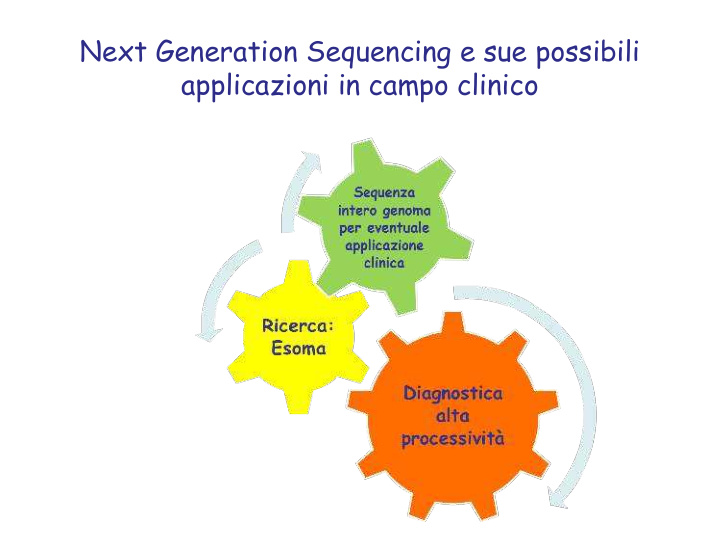



Next Generation Sequencing e sue possibili applicazioni in campo clinico
NGS per Diagnostica
Eterogeneità Genetica Il concetto classico di Eterogeneità genetica implica il fatto che la stessa condizione può essere causata da mutazioni in geni differenti e questo sta divenendo un problema consistente in Genetica Medica Per alcune malattie il grado di eterogeneità genetica è tale che ci sono più di 100 geni che possono causare la stessa malattia
La Retinite Pigmentosa (RP) è un gruppo eterogeneo di malattie ereditarie caratterizzato dalla progressiva perdita della vista, cecità notturna e depositi di pigmento nella retina.
NGS per Ricerca
Geography of exome sequencing Schinzel-Giedion Na tG e ne t Apr 1 0 Miller syndrome HPMR Kabuki syndrome Na t G e ne t N ov 0 9 Na tG e ne t Aug 1 0 Na tG e ne t Aug 1 0 DFNB82 A m J Hum G e ne t J un 1 0 Perrault syndrome A m J Hum G e ne t J ul 1 0 Brain Malformation Na ture Aug 1 0
UNITED WE STAND
DE NOVO
COMPOUND HETEROZYGOSITY
HOMOZYGOSITY
Sindromi malformative
Malattie Mendeliane non Sindromiche
FA2H causes SPG35 and leukodystrophy
Two affected sibs from a consanguineous family carry a c.270+3A>T mutation in the FA2H gene exon 1 exon 2 L R G E Q Q G S M E N E P V L R G E Q Q V Q P G R G P P
Single Nucleotide Variants SNVs Sib1 Sib 2 Validated 20967 22651 Transition to transversion ratio 2.91 2.89 In dbSNP 19727 (94%) 21237 (94%) Heterozygous in dbSNP 10372 11159 Homozygous in dbSNP 9355 10078 Not in dbSNP 1240 (6%) 1414 (6%) Heterozygous not in dbSNP 1086 1234 Homozygous not in dbSNP 130 154 180
Candidate variants filtering Cumulative total calls: 22711 ROHs in common: 28 No 1000 genomes: 8 NS, in UTRs, SS, nonsense: 28 Cumulative no dbSNPs: 1968 2 NS (1 gene) damaging by at least one prediction tool (SNP&GO, Polyphen, SIFT) 1 altering SS by at least one prediction tool (NetGene2, GDB) +1bp del
A novel FA2H c.270+3A>T splice site mutation in an Italian consanguineous pedigree
Malattie legate al cromosoma X
TARGETED RESEQUENCING OF X CHROMOSOME EXONS TARGETED RESEQUENCING OF X CHROMOSOME EXONS Length (Mb) ~ 150 CCDS entries 1153 RefSeq entries 2036 OMIM loci/genes 716 Agilent SureSelect human X chromosome 7664 probes Probe/CCDS genomic regions overlap 95% I 1 2 1 2 1 2 1 2 Probe/RefSeq genomic regions overlap 94% II 1 1 2 1 2 1 2
A CASE STUDIED WITH BOTH “CLASSICAL” A CASE STUDIED WITH BOTH “CLASSICAL” AND “NEXT GENERATION” APPROACHES AND “NEXT GENERATION” APPROACHES X-linked recurrence of a previously undescribed neurocutaneous phenotype Individuals III-2 and III-4: microcephaly, neurodevelopmental delay, ichthyosis, epilepsy, tetraparesis and ACC Male fetus III-3: ACC callosum and hyperkeratosis of epidermis with desquamation at the autoptic examination after voluntary abortion Individuals I-2, II-2 and II-3: mild ichthyosis limited to the extensor surfaces of Limbs compatible with a balanced chromosome X inactivation pattern
POSITIONAL CLONING OF A PAK3 PAK3 VARIANT VARIANT POSITIONAL CLONING OF A . Magini et al., submitted
NGS-BASED DETECTION OF A PAK3 PAK3 VARIANT VARIANT NGS-BASED DETECTION OF A GEN LINKAG CHR BAND hg19 CHANGE SANGER E E . p.L515 ? Xp22.31 STS 7268094 + - P . Xp22.12 MAP3K15 19443659 p.P477T + - . Xq13.1 STARD8 67940201 p.G582fs - - . p.K389 Xq23 PAK3 110439126 + + N
Recommend
More recommend